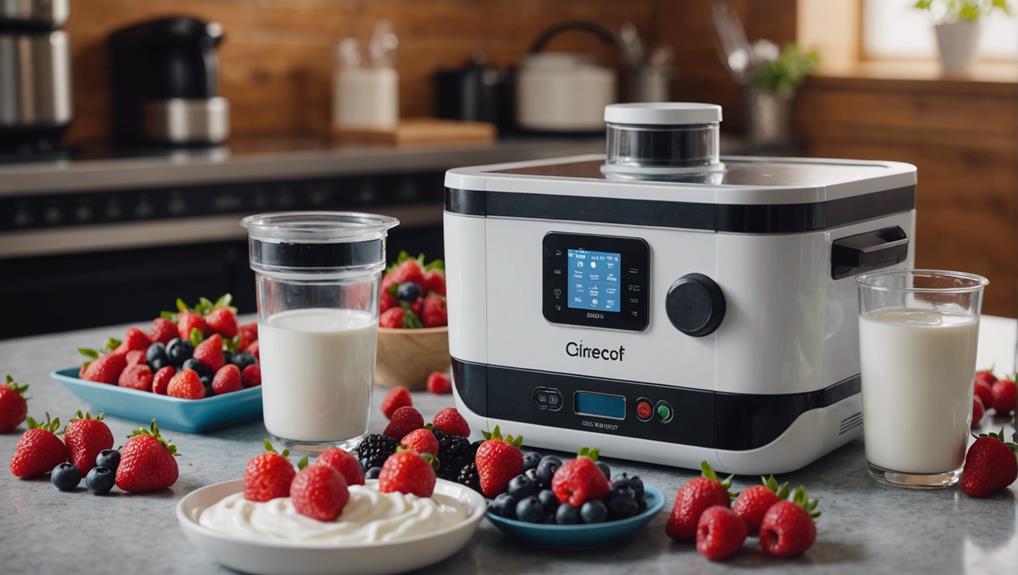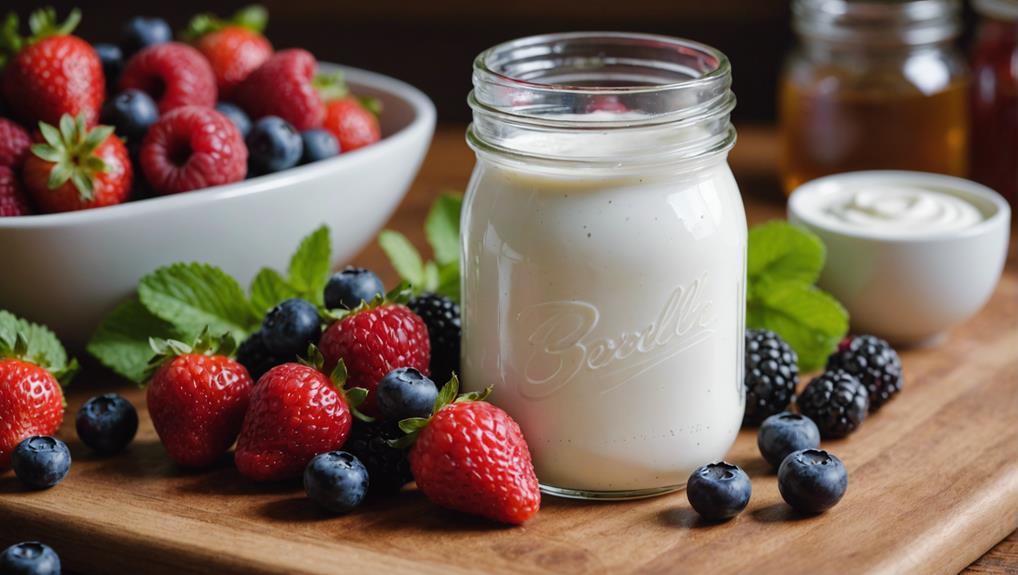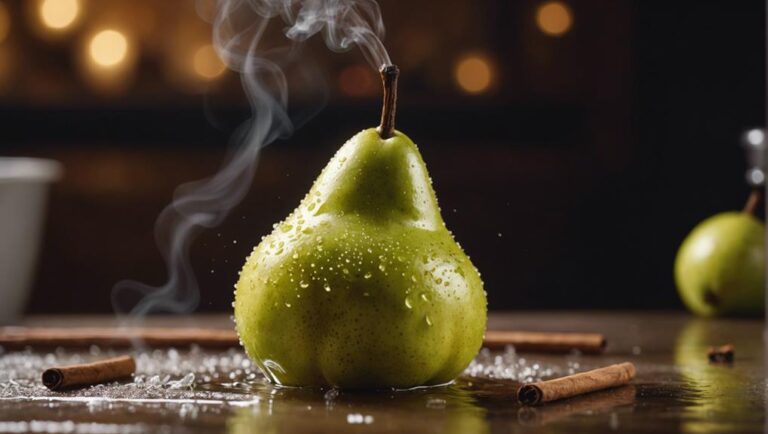"Sous Vide Greek Yogurt With Fresh Berries
Achieve creamy perfection with Sous Vide Greek Yogurt with Fresh Berries. Utilize precise temperature control for a velvety smooth texture and an explosion of fruity flavors. Enhance your culinary experience with this method.
What You Will Learn Here
- Sous vide method enhances yogurt creaminess and flavor.
- Precise temperature control ensures consistent texture and taste.
- Velvety smoothness and tangy notes characterize Greek yogurt.
- Experiment with fruit combinations for varied richness.
- Adjust cooking time for personalized yogurt texture.
Yogurt-Making Techniques

You'll explore various yogurt culture types to determine the flavor and consistency you desire.
Understanding the milk heating process is essential for activating the cultures and achieving the right texture.
Straining the yogurt post-fermentation is a key step for enhancing thickness and creaminess.
Yogurt Culture Types
Different yogurt culture types play an essential role in determining the flavor and texture of homemade yogurt. Yogurt culture diversity provides a range of options to experiment with, allowing you to create yogurt tailored to your preferences.
Each culture contributes unique flavors and textures through the fermentation process benefits, which include enhancing the tanginess, thickness, and creaminess of the yogurt. By selecting specific cultures, you can achieve varying levels of tartness or sweetness, as well as control the consistency of the final product.
Understanding the characteristics of different yogurt cultures empowers you to customize your yogurt-making process and achieve the desired taste and texture in your homemade yogurt.
Milk Heating Process
To initiate the milk heating process for yogurt-making, begin by carefully monitoring the temperature to guarantee optimal conditions for the fermentation of the cultures. Proper milk pasteurization is vital to eliminate harmful bacteria that could impact the yogurt fermentation process.
Heating the milk to around 180°F (82°C) and maintaining this temperature for about 30 minutes helps create a clean environment for the yogurt cultures to thrive. Cooling the milk to the desired fermentation temperature, typically between 110-115°F (43-46°C), is essential to make sure the cultures can activate and begin the fermentation process effectively.
Straining for Thickness
During the straining process for thickness in yogurt-making, the removal of excess whey through a fine mesh or cheesecloth results in a creamy and luxurious texture. Straining techniques play an important role in achieving the desired consistency of Greek yogurt.
By allowing the yogurt to sit in the cloth, the whey drips out, leaving behind a thicker product. For those seeking ultimate thickness control, varying the straining time can make a significant difference. Experimenting with different straining durations can lead to a range of textures, from slightly thick to incredibly dense yogurt.
Additionally, this step opens up opportunities for flavor experimentation. Adjusting the straining process alongside different recipe variations can help create a customized yogurt experience tailored to your preferences.
Key Yogurt-Making Components

Consider incorporating specific ingredients and tools when preparing yogurt at home to guarantee the best results. To guarantee successful yogurt fermentation and achieve the desired consistency, the following components are essential:
- Starter Culture: Utilize a high-quality starter culture containing live bacteria strains like Lactobacillus bulgaricus and Streptococcus thermophilus to kickstart the fermentation process effectively.
- Milk: Opt for fresh whole milk with no additives for the best yogurt consistency. Whole milk provides the necessary fat content to achieve a creamy texture.
- Thermometer: Use a reliable thermometer to monitor the milk's temperature accurately during the heating and cooling stages. Maintaining the correct temperature is important for proper yogurt fermentation and consistency.
Yogurt Parfait Ideas
Explore a variety of yogurt parfait ideas like the Berry-Infused Yogurt Parfait, Whipped Honey Yogurt Dip, and the Honey-Lavender Yogurt Parfait. These combinations offer a delightful mix of flavors and textures that are sure to elevate your yogurt experience.
Get ready to experiment with different ingredients to create your perfect yogurt parfait.
Berry-Infused Yogurt Parfait
To create a delightful Berry-Infused Yogurt Parfait, begin by layering Greek yogurt with a generous amount of fresh, vibrant berries. This simple yet satisfying treat offers a perfect balance between creamy yogurt and the natural sweetness of the berries.
Here's how to maximize the enjoyment of this fruity dessert:
- Mix it Up: Experiment with different berries like strawberries, blueberries, and raspberries for a variety of flavors and textures.
- Add Crunch: Enhance your parfait by sprinkling granola or chopped nuts between the yogurt and berry layers for a delightful crunch.
- Drizzle Sweetness: Finish off your parfait by drizzling a touch of honey or a fruity syrup on top for an added layer of sweetness.
Whipped Honey Yogurt Dip
Moving seamlessly from the berry-infused yogurt parfait, enhance your yogurt game with a luscious Whipped Honey Yogurt Dip that adds a delightful twist to your yogurt parfait ideas. Here are three ways to elevate your yogurt parfait with this delicious dip:
- Flavorful Toppings: Sprinkle crushed pistachios or toasted coconut flakes over the Whipped Honey Yogurt Dip for a contrasting texture that complements the creamy sweetness.
- Creative Pairings: Pair the Whipped Honey Yogurt Dip with sliced mangoes or grilled peaches to introduce a tropical flair to your parfait, balancing the tangy yogurt with a burst of fruity freshness.
- Layered Delight: Create a multi-layered parfait by alternating between the Whipped Honey Yogurt Dip and granola, building a symphony of flavors and textures in every spoonful.
Honey-Lavender Yogurt Parfait
Indulge in a harmonious blend of honey and lavender flavors with this exquisite Honey-Lavender Yogurt Parfait. Lavender honey adds a delicate floral note to the creamy yogurt, creating a luxurious treat perfect for any time of the day.
Elevate your parfait game with these tips:
- Layering Perfection: Alternate between yogurt, granola, and fresh berries for a delightful texture and taste contrast.
- Drizzle of Lavender Honey: Finish off your parfait with a generous drizzle of lavender honey to enhance the floral aroma and sweetness.
- Creative Yogurt Toppings: Experiment with toppings like toasted nuts, chia seeds, or edible flowers to add crunch and visual appeal to your parfait.
Experience a symphony of flavors and textures with this Honey-Lavender Yogurt Parfait.
Yogurt-Setting Temperature Recommendations
When setting yogurt, maintaining an ideal temperature is essential for a successful outcome. Factors such as incubation time, milk type, and starter culture can influence the setting process.
Ensuring precise temperature control is paramount to achieve the desired consistency and taste in your homemade yogurt.
Ideal Temperature for Setting
To achieve the ideal setting for your yogurt, maintain a consistent temperature within the suggested range specified for best results. Temperature control is vital during the fermentation process to guarantee proper gel formation and prevent protein denaturation.
For Greek yogurt, the optimal temperature for setting typically ranges between 110°F to 115°F (43°C to 46°C). This temperature range encourages the cultures to efficiently convert milk into yogurt while promoting the development of a thick and creamy texture.
Fluctuations outside this range can lead to inconsistent results, impacting the final texture and taste of the yogurt. By closely monitoring and regulating the temperature within the recommended parameters, you can optimize the yogurt-setting process and achieve a delicious homemade Greek yogurt every time.
Factors Affecting Yogurt Setting
Maintain strict control over the temperature within the vital range to guarantee successful yogurt setting and avoid undesirable outcomes. Temperature control is important in the yogurt-making process.
To achieve excellent results, make sure that the milk is heated to around 185°F (85°C) before cooling it to the ideal incubation temperature of 110°F (43°C) for the cultures to thrive. Incorrect temperatures can lead to runny or overly thick yogurt due to improper fermentation.
Additionally, ingredient selection plays a key role in yogurt setting. Using high-quality milk with the right fat content and selecting a starter culture with live and active probiotics are essential for a creamy and tangy yogurt.
Importance of Precise Temperature
For ideal yogurt setting, precise temperature control within the recommended range is paramount to achieve the desired consistency and quality in your homemade yogurt. Temperature control is vital in precision cooking, especially when making yogurt. Below is a table outlining the recommended temperature ranges for setting yogurt using the sous vide method:
| Yogurt Type | Temperature Range |
|---|---|
| Regular Yogurt | 110°F – 115°F |
| Greek Yogurt | 110°F – 115°F |
| Skyr | 110°F – 115°F |
| Plant-Based Yogurt | 110°F – 115°F |
Maintaining the temperature within these ranges guarantees the proper culturing of the yogurt, resulting in a creamy and delicious final product. Remember, precise temperature control is key to achieving the perfect homemade yogurt every time.
Final Thoughts
When considering the overall process and results of making Sous Vide Greek Yogurt with Fresh Berries, it's evident that the technique consistently delivers a creamy texture and intense flavors that elevate the traditional yogurt experience. Reflections on this culinary journey reveal that the precise temperature control during the sous vide cooking method is vital for achieving the desired consistency and taste. The slow, controlled cooking process allows the yogurt to develop a velvety smoothness while maintaining the tangy notes characteristic of Greek yogurt.
Culinary tips for those venturing into the world of sous vide yogurt include experimenting with different fruit combinations to complement the richness of the yogurt base. The sous vide method excels in infusing flavors, making it ideal for creating harmonious blends with various berries or even tropical fruits like mangoes and passionfruit. Additionally, adjusting the cooking time can subtly alter the final texture, offering a personalized touch to this already versatile dish.
Frequently Asked Questions
Can I Use Frozen Berries Instead of Fresh Ones?
Yes, you can use frozen berries instead of fresh ones as a substitution option. Frozen berries work well in many recipes and can be a convenient alternative. Consider adjusting cooking times for best results.
How Long Can I Store Homemade Yogurt in the Fridge?
You can store homemade yogurt in the fridge for about 7-10 days. To prolong yogurt shelf life, guarantee a sealed container, maintain consistent cold temperatures, and avoid cross-contamination. Following these storage tips will help preserve freshness.
Is It Possible to Make Dairy-Free Greek Yogurt?
You can make dairy-free Greek yogurt using plant-based alternatives like coconut milk or almond milk. These options offer similar nutritional benefits as dairy Greek yogurt, such as probiotics and protein, making them a great alternative for those with dietary restrictions.
Can I Use Flavored Yogurt for This Recipe?
You can use flavored yogurt for this recipe, but be mindful of flavoring options. Adjust the sweetness or intensity to match your preferences. Consider how the added flavors might affect the overall taste and texture of the dish.
What Are Some Alternative Sweeteners for the Yogurt?
For sweetening yogurt, consider using stevia for a calorie-free option or honey for a natural touch. Maple syrup and agave are also great alternatives with unique flavors. Experiment to find the sweetener that suits your taste preferences.
Conclusion
To sum up, mastering the art of making sous vide Greek yogurt with fresh berries requires attention to detail and precision. By understanding the key components and recommended temperature settings, you can create a creamy and delicious yogurt that's perfect for enjoying on its own or in a parfait.
Experiment with different fruits and toppings to customize your yogurt to your liking. With practice and patience, you can become a yogurt-making expert in no time.











